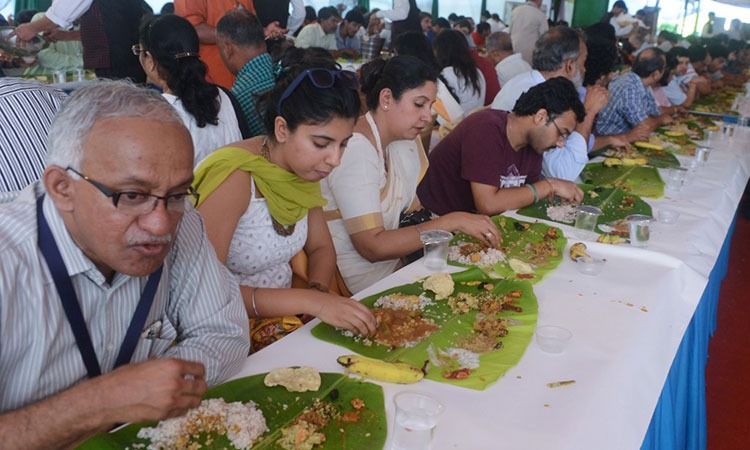
आज इस दसवें वार्षिक अन्तर्राष्ट्रीय योग दिवस के उपलक्ष में आज का विषय रखा है – योग और संस्कृति या योग और भारतीय संस्कृति। इस पर हम थोड़ा सा विचार विमर्श करेंगे। तो ये जानना जरूरी है संस्कृति है क्या? अब ये ऐसे तो संस्कृति, जो भी काम करें वो एक संस्कार के साथ करें, समानता के साथ करें, उसको शाब्दिक रूप में ‘संस्कृति’ कहा जा सकता है। लेकिन वो व्यवहार क्या हैं? वो हमारी बातें क्या हैं जो संस्कृति में आती हैं या जिसको अंग्रेजी में ‘कल्चर’ कहते हैं।
वैसे बैक्टीरिया का भी कल्चर होता है, उसको ग्रो जिस परिस्थिति में करते हैं वो उसको कल्चर कहते हैं, बैक्टीरियल कल्चर कहते हैं, बड़ा इण्ट्रेस्टिंग चीज है कि ये इसमें दोनों में क्या समानता है? क्योंकि जिसमें हमारी ग्रोथ हो उसी को हमारी कल्चर कहते हैं, उसी को संस्कृति कहते हैं। जैसे बैक्टीरिया जिस मीडियम में हम डालते हैं, उसमें उसका ग्रोथ होता है तो उसे हम बैक्टीरियल कल्चर कहते हैं। उसी तरह से जिसमें मनुष्य की प्रगति हो, उसका विकास हो, उसको संस्कृति कहते हैं। उसके हम प्रैक्टिकल रूप से यह कहना चाहते हैं कि प्रैक्टिकल रूप से तीन चार उसके तत्त्व हैं जिसके बारे में हम बात करना चाहते हैं।

संस्कृति में अगर आप जोड़िए तो एक भाषा आती है, क्योंकि हम एक दूसरे से कम्युनिकेट करते हैं। भारत में कई भाषाएँ हैं, इसमें लोगों को ये हो सकता है कि फिर ये हमारी तो संस्कृति एक है नहीं। नहीं, भाषा एक अभिव्यक्ति का माध्यम है। उस अभिव्यक्ति से हम किस तरह से अभिव्यक्ति करते हैं, किस बात की अभिव्यक्ति करते हैं, किस तरह से उस अभिव्यक्ति को सुनते हैं, समझते हैं और किस तरह से अपने जीवन में उतारते हैं, ये चीज ज्यादा जरुरी है। तो भाषा की जो अभिव्यक्ति है अगर हम भाषा को देखना चाहते हैं तो भाषा जो है हमारे यहाँ की, मूल भाषा है वो संस्कृत भाषा है। वो ऐसा माना जाता है कि सिर्फ हमारे यहाँ की ही नहीं बल्कि सारे विश्व की मूल भाषा जो है वो संस्कृत भाषा है। बाद में उसको अंग्रेजों ने इण्डो यूरोपियन भाषा एक बनाया, उसमें से संस्कृत को निकाला। ये लेकिन एक डिबेट का विषय है कि इण्डोयूरोपियन भाषा पहले आई कि इण्डोयूरोपियन भाषा को एक नाम दे के संस्कृत भाषा को उसके थोड़ा सा पीछे बताया गया जिससे यूरोपियन भाषाओं का भी अपना एक महत्त्व बने।
ये तो सत्य है कि यूरोप और भारत, ये सारे देश एक साथ ही इस संसार में आए हैं तो उनकी अपनी भाषाएँ होंगी ही, लेकिन संस्कृत भाषा जो है वह बड़ी ही सुदृढ़ भाषा है जिसको ये कहा जाता है कि ये एक ऐसी भाषा है, इसका जो व्याकरण है वो कम से कम तीन हजार साल से बदला नहीं है। इसलिए इसको कहते हैं कि ये कम्प्यूटर की भाषा भी बहुत अच्छे से हो सकती है क्योंकि इसमें बदलाव नहीं होता है। इसको एक मानक बनाया जा सकता है।
ऐसा एक प्रोफेसर नोम चॉम्स्की एम० आई० टी० में हैं, वो ऐसा कहते हैं बल्कि उन्होंने कोशिश किया कि अंग्रेजी भाषा को भी इस तरह की भाषा बनाई जाय, जिसमें उसमें परिवर्तन न हो, लेकिन हर दूसरे साल में ही वह फेल हो जाती है। क्योंकि उसकी उत्पत्ति उस तरह से नहीं है। अब ज्यादा उसमें नहीं जाना चाहते क्योंकि आज विषय हमारा थोड़ा दूसरा है। सिर्फ भाषा पर नहीं बात करना चाहते। लेकिन संस्कृत भाषा की बहुत ही महिमा है। और उसके अक्षर कहाँ से निकलते हैं, अक्षर का मतलब क्या होता है जिसका क्षय नहीं हो, वह केमिस्ट्री से कैसे जुड़ता है क्योंकि जो अक्षर है जो उसकी मीनिंग है हमारी केमिस्ट्री में एटम की होती है। तो इस तरह से हम इसको वहाँ से भी जोड़ सकते हैं इसका बड़ा साइण्टिफिक उत्पत्ति है इसलिए हम उसको मानते हैं संस्कृत की उत्पत्ति है फिर संस्कृत में हमारी ओर भाषाओं का किस तरह से उनका सम्बन्ध है ये भी भारत की शायद सभी भाषाओं से सम्बन्ध है इसको भी जानें। इसको तमिल भाषा में भी संस्कृत के ४० फीसदी या ऐसे डॉ० सुब्रह्मण्यम स्वामी ने एक बार एक लेक्चर में कहा था कि वहाँ के जो शब्द हैं वो भी संस्कृत से जुड़े हुए हैं क्योंकि जिसको कि लोग ऐसा मानते हैं कि वो एक अलग भाषा है, वो है भी बहुत पुरानी भाषा। और तमिल कल्चर जो है उसमें बड़ी महानता है ये सब सत्य है लेकिन मैं अभी सिर्फ भाषा पर बात कर रहा हूँ तो भाषा में, भाषा जो है हमारे संस्कृति का एक अंग है और उसमें एक चीज है कि जो हमारी भाषा में, हर भारतीय भाषा में यहाँ तक कि जो उर्दू भाषा है, वह भी भारतीय भाषा है, उसमें हम पहले कर्ता, फिर कर्म और उसके बाद क्रिया पर जाते हैं। यह व्याकरण जो है वह हर भारतीय भाषा पर लागू होता है, तो ये देखिए तो उसमें एक समानता मिल जाती है उसी तरह से उसका एक दूसरा अंग जो होता है किसी भी कल्चर या संस्कृति का, वो होता है भोजन, कि आप क्या खाते हैं, कब खाते हैं, कैसे खाते हैं।
भारत में हर जगह लोग हाथ से भोजन करते हैं। कभी-कभी बाहर के लोगों को ऐसा लगता है कि ये तो बड़ी ट्राइबल मेण्टलिटी है, बैकवर्डनेस है। उनके पास चम्मच नहीं रहा होगा, मान लीजिए कि चम्मच नहीं रहा होगा, मान लीजिए कि ये बात सही है लेकिन ये देखने वाली बात है कि जिस संस्कृति में, जिस कल्चर में हम पूरे ब्रह्माण्ड की व्याख्या करने के लिए बैठे रहते हैं, एक-एक कण की बात करते हैं वो चम्मच नहीं बना सकता? जहाँ पर ब्रह्मास्त्र की बात हुई हो वह चम्मच नहीं बना सकता? या चम्मच से खा नहीं सकता? ये बड़ी विडम्बना लगती है। इसलिए उसका दूसरा कारण यह है कि जब हम किसी भोजन को करते हैं तो भोजन से जुड़ते हैं, भोजन जो करते हैं अभी अगर आप, जैसे हाथ भी लोग मिलाते हैं हाथ जब मिलाते हैं तो कोई सही में एक दूसरे को टच नहीं करता है, उसकी जो ‘औरा’ होती है जो इनर्जी होती है वो लगता है कि मिल रही है लेकिन लोगों ने माइक्रोस्कोप में देखा हुआ है कि कुछ ऐंगस्ट्रम का फर्क रहता है इसलिए जो हम भोजन करते हैं वह भी हम अपने शरीर में मिलाते हैं। यह एक तरह का योग है, और जो भोजन हम कर रहे हैं। ऐसे तो एकदम से टच नहीं करता है लेकिन हमारे ऊपर उसका प्रभाव पड़ता है। एक दूसरे को हम प्रभावित करते हैं। तो जब हम भोजन हाथ से खाते हैं तो हमारी जो पाँचों ज्ञानेन्द्रियाँ हैं, भोजन को हम सिर्फ स्वाद से नहीं खाते।
आप कभी टेस्ट करके देख लीजिए अगर आपको कभी सेब खाना है, आम खाना है, अमरूद खाना है आप नाक बन्द करके खाइए, आपको उसका स्वाद दूसरा लगेगा। इसका मतलब है कि हमारी जो घ्राणशक्ति है उसका भी प्रभाव है, स्वाद पर भी ये प्रभाव है। आप उसको मत देखिए तो उसका दूसरा प्रभाव पड़ेगा। तो हमारी जो पाँचों ज्ञानेन्द्रियाँ हैं इनका प्रभाव पड़ता है। हाथ से स्पर्श का जो भाव है वो देते हैं। और ऐसा कहा गया है, ऐसा एक्सपेरिमेण्ट भी किया गया है जब हाथ से आप भोजन शुरू करते हैं तब आपके अन्दर जो डाइजेस्टिव स्राव होते हैं, जो एन्जाइम्स होते हैं उनका प्रवाह शुरू हो जाता है। क्योंकि जब आप टच करते हैं तब से हो जाता है। तो ये डाइजेस्चन क्रिया है, डाइजेस्चन क्रिया के लिए हम हाथ से खाते हैं इसलिए नहीं कि हम बैकवर्ड हैं हमको चम्मच बनाना नहीं आता या हम चम्मच से खाना नहीं जानते हैं। ऐसी बात नहीं है। चम्मच से खाना ठीक है आप खाइए जिसको-जिसको खाना है लेकिन अगर सही में आप पूरा उपयोग करना चाहते हैं, अपनी हर क्रिया में योग डालना चाहते हैं। जो कि संस्कृति में बनाना चाहते हैं आपका कल्चर बन जाना चाहिए, उसमें आपको भोजन हाथ से ही खाना चाहिए। और पूरा उसको देखिए, उस पर ध्यान दीजिए। और कहते हैं कि भोजन करते समय बातचीत नहीं करनी चाहिए क्योंकि ध्यान बँट जाता है, आप कर सकते हैं ऐसे बहुत सारे मल्टीटास्किंग कर सकते हैं लेकिन उसके लिए बड़ा अभ्यास करना पड़ता है।
अगर आप बहुत अभ्यास कर लें एकाग्र होकर भोजन करने का, फिर आप दूसरा काम करें आपकी एकाग्रता इसमें से छूटे नहीं तब आप दूसरा भी काम कर सकते हैं। मल्टीटास्किंग का मतलब ये नहीं है कि इसको छोड़कर आप उसको करें। ऐसा नहीं है और मल्टीटास्किंग, कभी दौड़कर ये कर रहे हैं कभी दौड़कर वो कर रहे हैं। नहीं, आप एक साथ कर सकते हैं, हमारा शरीर सारा काम एक साथ करता है। क्योंकि उसमें अन्दर योग है, (वह) जुड़ा हुआ है। हर चीज जुड़ा हुआ है उस भाव से जुड़ा हुआ है जिस भाव से जुड़ना चाहिए। तो यह हो गया भोजन, इसकी बड़ी महिमा है, भोजन के बारे में बहुत सारी बातें हम कर सकते हैं।
प्रोफेसर बलराम सिंह, निदेशक, स्कूल ऑफ़ इंडिक स्टडीज़, इंस्टिट्यूट ऑफ़ एडवांस्ड साइंसेज़, डार्टमाउथ, मेसाचुसेट्स, यूएसए




